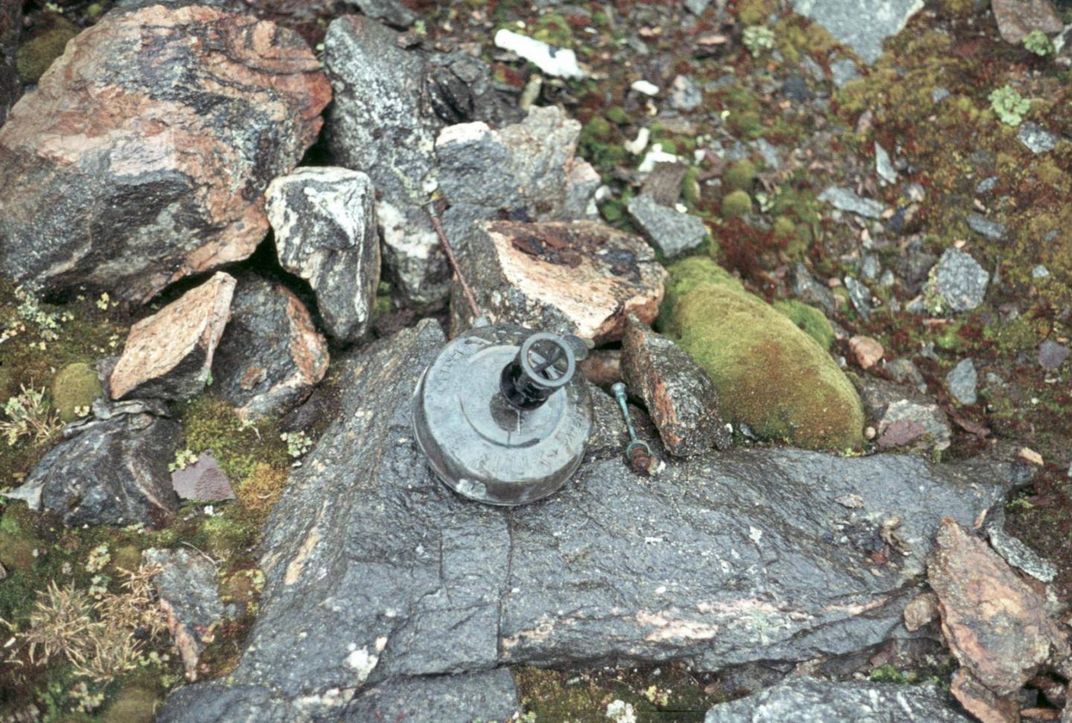Black Smudge on Diary Page Reveals 1907 Arctic Expedition’s Tragic End
New analysis suggests explorer Jørgen Brønlund spent his final hours trying—and failing—to light a petroleum burner
:focal(747x507:748x508)/https://tf-cmsv2-smithsonianmag-media.s3.amazonaws.com/filer/3c/53/3c53dc9e-f246-433d-8b4d-93634c37e91d/249770_web.jpg)
In late November 1907, explorer Jørgen Brønlund recorded a stark final diary entry. Huddled in a small Arctic cave, near death due to starvation and freezing temperatures, he wrote, “I reached this place under a waning moon, and cannot go on, because of my frozen feet and the darkness.”
The 29-year-old concluded, “The bodies of the others are in the middle of the fjord.”
More than a century later, reports Mindy Weisberger for Live Science, chemists from the University of Southern Denmark have shed light on the end of Brønlund’s life by analyzing a bit of black material smeared on the last page of his journal. Their findings, published in the journal Archaeometry, identify the substance as a mix of burnt rubber, oil and feces—likely remnants of a last, desperate attempt to light a petroleum burner.
“I see for me, how he, weakened and with dirty, shaking hands, fumbled in an attempt to light the burner, but failed,” says lead author Kaare Lund Rasmussen in a statement.
At the time of his death, Brønlund, a Greeland-born Inuit, had a petroleum burner, matches and petroleum, but no metabolized alcohol to preheat the burner.

“He had to find something else to get the burner going,” Rasmussen explains. “You can use paper or oiled fabric, but it is difficult. We think he tried with the oils available, because the black spot contains traces of vegetable oil and oils that may come from fish, animals or wax candles.”
Per Atlas Obscura’s Luna Shyr, Brønlund’s three-man sledge team ran into trouble while attempting to return to the Denmark Expedition’s base camp in Danmarkshavn. Led by explorer Ludvig Mylius-Erichsen, the group had set out to determine whether Peary Land, a territory in northeastern Greenland, was a peninsula or an island. The former would give Denmark a strong claim to the area, while the latter would offer an advantage to the United States.
Brønlund, Mylius-Erichsen and cartographer Niels Peter Høeg Hagen spent the summer of 1907 in a fjord, where they waited for the ice and snow that would enable them to travel back to camp. But by the time the trio started out again in the fall, they were exhausted and hungry. Brønlund’s companions died within days of each other in mid- to late November; he persevered for another 15 miles to reach the cave where he ultimately died.
A search party found Brønlund’s body and diary, along with sketches made by Hagen, in the spring of 1908. Hagen’s and Mylius-Erichsen’s bodies were never found. The Royal Library in Copenhagen took ownership of the explorer’s diary, and in 1993, an unnamed researcher acting without supervisors’ permission removed the black spot from its pages.

“The spot was immediately brought to the National Museum [of Denmark] for examination,” Rasmussen tells Live Science. “There was no commercial or otherwise gain for this person. Nowadays, we do not analyze samples without written authorization, but it was entirely different then.”
In the 1990s, the technology needed to effectively analyze the material didn’t exist. But more recently, scientists were able to use X-ray fluorescence and inductively coupled plasma mass spectrometry to study the blotch at the atomic level and determine its chemical makeup. Some of the mixture probably came from the rubber gasket in the burner Brønlund was trying to light. The presence of fecal matter, meanwhile, could suggest that the explorer made a desperate attempt to burn his own excrement, or it could simply reflect the terrible conditions he faced in his final hours.
Despite everything, Rasmussen tells Atlas Obscura, there’s no evidence that Brønlund used his diary, which contained evidence that Peary Land was indeed a peninsula, in his efforts to light the burner.
“I think the diary was something he knew other people would read, so he would preserve that by all means,” he says. “Just think of it: He realized he would die very soon, and he really protected his diary and the information they had gathered. You could say that the acts of Brønlund meant the expedition was fulfilled in a way, because the information got back.”
/https://tf-cmsv2-smithsonianmag-media.s3.amazonaws.com/accounts/headshot/Livia_lg_thumbnail.png)
/https://tf-cmsv2-smithsonianmag-media.s3.amazonaws.com/accounts/headshot/Livia_lg_thumbnail.png)